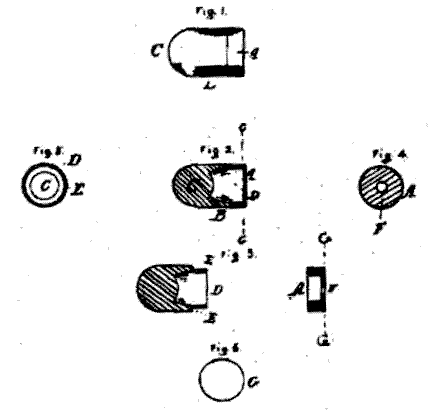
Rocket Ball
Encyclopedia

The Rocket Ball was one of the earliest forms of metallic cartridge
Cartridge (firearms)
A cartridge, also called a round, packages the bullet, gunpowder and primer into a single metallic case precisely made to fit the firing chamber of a firearm. The primer is a small charge of impact-sensitive chemical that may be located at the center of the case head or at its rim . Electrically...
for firearms, containing bullet
Bullet
A bullet is a projectile propelled by a firearm, sling, or air gun. Bullets do not normally contain explosives, but damage the intended target by impact and penetration...
and powder in a single, metal cased unit.
Construction
The Rocket Ball, patented in 1848 by Walter HuntWalter Hunt
Walter Hunt was an American mechanic. He lived and worked in New York state. Through the course of his work he became renowned for being a prolific inventor, notably of the lockstitch sewing machine , safety pin , a forerunner of the Winchester repeating rifle, a successful flax spinner, knife...
, consisted of a lead
Lead
Lead is a main-group element in the carbon group with the symbol Pb and atomic number 82. Lead is a soft, malleable poor metal. It is also counted as one of the heavy metals. Metallic lead has a bluish-white color after being freshly cut, but it soon tarnishes to a dull grayish color when exposed...
bullet with a deep hollow in the rear, running a majority of the length of the cartridge. The hollow, like that of the Minie ball
Minié ball
The Minié ball is a type of muzzle-loading spin-stabilising rifle bullet named after its co-developer, Claude-Étienne Minié, inventor of the Minié rifle...
, served to seal the bullet into the bore, but Rocket Ball put the cavity to further use. By packaging the deep cavity with powder, and sealing it with a cap with a small hole in the rear for ignition, the Rocket Ball replaced the earlier paper cartridge
Paper cartridge
Paper cartridge refers to one of various types of small arms ammunition used before the advent of the metallic cartridge. These cartridges consisted of a paper cylinder or cone containing the bullet, gunpowder, and, in some cases, a primer or a lubricating and anti-fouling agent...
with a durable package capable of being fed from a magazine. The cap was blown out of the bore upon firing, leaving no cartridge case to be ejected, making the Rocket Ball a form of caseless ammunition
Caseless ammunition
Caseless ammunition is a type of small arms ammunition that eliminates the cartridge case that typically holds the primer, propellant, and projectile together as a unit...
. The Rocket Ball was used in the earliest magazine fed lever action guns, allowing the first practical repeating, single chamber firearms.
Use

Muzzle energy
Muzzle energy is the kinetic energy of a bullet as it is expelled from the muzzle of a firearm. It is often used as a rough indication of the destructive potential of a given firearm or load...
of only about 56 foot-pounds (76 joule
Joule
The joule ; symbol J) is a derived unit of energy or work in the International System of Units. It is equal to the energy expended in applying a force of one newton through a distance of one metre , or in passing an electric current of one ampere through a resistance of one ohm for one second...
s), the Rocket Ball was less powerful than even the feeblest of modern "pocket pistol
Pocket pistol
A pocket pistol is an American term for any small, pocket-sized semi-automatic pistol or, less-popular, any other handgun of small caliber, suitable for concealed carry in either a front or rear pocket of a pair of trousers, or in an exterior coat pocket...
" cartridges, such as .25 ACP
.25 ACP
The .25 ACP centerfire pistol cartridge is a semi-rimmed, straight-walled pistol cartridge introduced by John Browning in 1905 alongside the Fabrique Nationale model 1905 pistol...
.
Despite these limitations, the Rocket Ball was used in a number of attempts at making a commercially successful firearm, culminating in the Volcanic Repeating Arms
Volcanic Repeating Arms
The Volcanic Repeating Arms Company was a company formed in 1855 by partners Horace Smith and Daniel B. Wesson to develop Walter Hunt's Rocket Ball ammunition and lever action mechanism. Volcanic made an improved version of the Rocket Ball ammunition, and a carbine and pistol version of the lever...
Company. The Volcanic cartridge went one step further, adding a primer to the cap of the Rocket Ball, making the ammunition completely self-contained.

